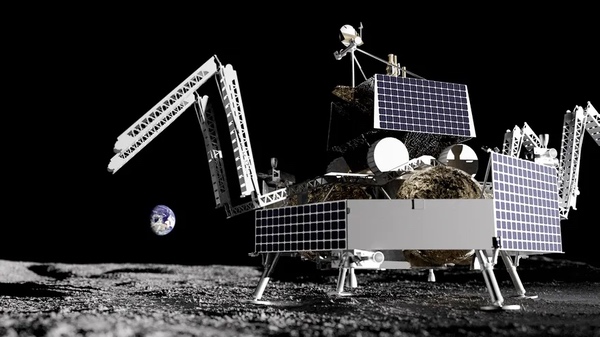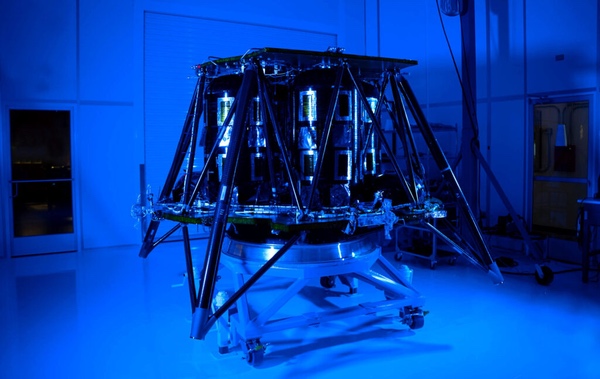
Lessons from the first CLPS lunar landing missionsby Jeff Foust
|
| Crain said he was confident that, had those laser rangefinders been working, “we would have nailed the landing.” |
“We have been listening since then and we will continue to listen,” said Trent Martin, senior vice president of space systems at the company, during a panel discussions Thursday at the American Astronautical Society’s Goddard Space Science Symposium at the University of Maryland. “I think it’s highly unlikely that it will, but there is a possibility and we will listen for the next couple of days.”
The company concluded Saturday that the spacecraft would not revive. “Odie’s power system would not complete another call home,” the company announced on social media. “This confirms that Odie has permanently faded after cementing its legacy into history as the first commercial lunar lander to land on the Moon.”
With both IM-1 and Astrobotic’s Peregrine missions now complete, both companies are taking stock of what they achieved and where they fell short as they plan their next missions.
In the case of IM-1, despite a hard landing that caused the land to fall almost on its side—the company ultimately concluded it was tipped at a 60-degree angle—it was able to operate most of the spacecraft’s payloads from NASA and commercial customers. At a briefing in late February, as the mission was winding down, both NASA and the company said that the NASA payloads in particular had generated at least some data.
In an earnings call Thursday, Steve Altemus, CEO of Intuitive Machines, said the company estimated it was in line to earn 95% of the payments the company was eligible for under its Commercial Lunar Payload Services (CLPS) task order from NASA for the mission. The missing 5%, he said, is the result of one payload, the Stereo Cameras for Lunar Plume-Surface Studies (SCALPSS). However, he said the company is talking with NASA about alternative data it could provide to meet that payload’s requirements and earn that remaining 5%.
Odysseus made a hard landing because its laser rangefinders were not operational: a safety switch, in place on the ground because the lasers are not eye-safe, was not flipped before launch. The company initially thought they could get around it by making a last-second patch to the lander’s software, allowing it to use data from one of the NASA payloads, the Navigation Doppler Lidar (NDL) instrument (see “The phases of lunar lander success, revisited”, The Space Review, February 26, 2024).
But at that late February briefing, the company disclosed that workaround didn’t work. Tim Crain, chief technology officer, said a “data flag” in the software was not set to allow it to use the NDL data. “So those did not process after all,” he said. “Basically, we landed with our IMU [inertial measurement unit] and our optical navigation data flow algorithms.”
The lander was intended to land straight down at a speed of about one meter per second. Instead, it landed at three meters per second and with about one meter per second of sideways motion. That was hard enough to break at least one landing leg and cause the lander to tip over.
Crain said he was confident that, had those laser rangefinders been working, “we would have nailed the landing.”
Altemus said on the earnings call that, as his company turns it attention to IM-2, it will make only minor changes to the Nova-C lander design. Besides ensuring the laser rangefinder is properly configured, he said there were a few other areas that “needed adjustment,” like antennas and cameras. “We don’t see any impact to the schedule based on the changes from IM-1. They’re fairly straightforward.”
That IM-2 mission is scheduled for launch in November, but he said NASA was interested in moving the landing locations slightly in the lunar south polar region to make it more likely the agency’s main payload, PRIME-1, can access water ice there. “We are still planning for a 2024 mission for IM-2,” he said.
 Astrobotic’s Griffin lander is designed to deliver NASA’s VIPER lunar rover. (credit: Astrobotic) |
Astrobotic’s Peregrine lander never made it to the Moon: a propellant leak several hours after its January 8 launch ruled out any landing attempt. The spacecraft’s mission ended a week and a half after its launch with a reentry over the South Pacific (see “The phases of lunar lander success”, The Space Review, January 22, 2024).
| “There will probably be some hardware impacts and some schedule impacts on Griffin,” Thornton said of Astrobotic’s next, larger lander. |
However, while the payloads on the lander from NASA and other customers didn’t make it to the surface of the Moon, they still were able to operate. During a session about the mission at the Lunar and Planetary Sciences Conference (LPSC) earlier this month, representatives of several of the payloads said they were able to operate, and in some cases collect science data, from them.
Those instruments were repurposed in some cases, such as radiation sensors intended to operate on the lunar surface but which instead took data in cislunar space. “We had to move our operations around to pull data down during the flight,” said Stuart George of NASA’s Johnson Space Center, one of the leaders of the Linear Energy Transfer Spectrometer instrument. “The instrument worked perfectly the whole time.”
Other payloads were instead put through their paces; a spectrometer, for example, was able to detect traces of the oxidizer that leaked out of Peregrine. Even Iris, a lunar rover built by students at Carnegie Mellon University, was tested while attached to the lander, testing many of its subsystems.
“We became a ‘RoverSat’ instead,” said Raewyn Duvall, program manager for Iris. “Everything that we were allowed to test worked.” She added that the student-led project even studied the feasibility of deploying the rover while in space, a proposal ultimately nixed by spacecraft controllers.
While the payload teams evaluated the data they were able to collect, Astrobotic has been investigating what went wrong with the lander. Even before the mission ended, the company said the likely cause of the propellant leak was a valve failure that caused helium to rush into an oxidizer tank, overpressurizing it.
Astrobotic established a failure investigation board, with an independent chair to come up with a root cause for the leak and corrective actions. “They’re making really good progress,” said Dan Hendrickson, vice president of business development at Astrobotic, during the Goddard Symposium panel.
That review “is close to wrapping up,” John Thornton, CEO of Astrobotic, said in an interview. “We’re going to be prepared to get all of the lessons learned out of that and into Griffin.”
Griffin is Astrobotic’s next lander, significantly larger than Peregrine. It will take to the south polar regions of the Moon NASA’s VIPER lunar rover. Even as the investigation is in progress work on Griffin is continuing, Thornton said.
Before Peregrine, NASA had projected a launch of Griffin carrying VIPER late this year, but the investigation into Peregrine and subsequent changes will likely delay it. “There will probably be some hardware impacts and some schedule impacts on Griffin, but we've got to finish that process to know exactly how much and where,” he said. Those hardware impacts, he said, will likely including replacing valves on Griffin.
NASA also expects Griffin to slip. “It is extremely unlikely they will fly before the end of this year,” Joel Kearns, deputy associate administrator for exploration in NASA’s Science Mission Directorate, said of that mission at a planetary science advisory committee meeting in early March.
He added at a town hall meeting at LPSC that NASA will wait until that failure review is complete before considering a revised scheduled for the mission. “We will look at their failure review board findings and determine what steps we need to take for VIPER.”
| “Although we selected 14 companies,” Kearns said, “it was never NASA’s goal to have government business for all 14 companies.” |
Astrobotic is also bringing in more expertise to help with Griffin. The company announced last week it had hired Steve Clarke, a former NASA official most recently at Sierra Space, as its vice president of landers and spacecraft, as well as Frank Peri, former head of the safety and mission assurance office at NASA’s Langley Research Center, as its director of engineering. Two former NASA associate administrators for space technology, Mike Gazarik and Jim Reuter, will also serve as advisors.
“I think the key there is to make sure that Astrobotic has access to as much experience as possible,” Thornton said. “They represent a nice cross section of industry and provide us reach back into many more segments of the industry.”
 The next CLPS mission currently scheduled to launch is Firefly’s Blue Ghost lander late this year. (credit: Firefly Aerospace) |
With two missions now complete, NASA and industry are taking stock of CLPS. The “shots on goal” philosophy espoused for the mission more than five years ago appears to have been vindicated: while neither mission was totally successful, there’s been no public outcry—or, more importantly, congressional criticism—about them.
Assuming Griffin/VIPER does slip beyond this year, NASA expects two more CLPS to launch this year: IM-2 and Blue Ghost, the first lunar lander by Firefly Aerospace. Firefly and Intuitive Machines each have an additional CLPS mission awarded by NASA, along with Draper.
At the planetary science advisory committee meeting early this month, committee members asked Kearns how to make CLPS sustainable. They pointed to examples like Masten Space Systems, which also won a CLPS award only to go bankrupt, and Orbit Beyond, which received a task order alongside Astrobotic and Intuitive Machines in 2019 only to return it two months later.
“We’ve taken steps since the initial task orders and since the Chapter 11 reorganization of Masten so that the way we’re doing those procurements, the criteria that we’re using, are actually different,” he said.
NASA still lists 14 companies as part of the CLPS program, a list that includes bankrupt Masten as well as several others that have shown little overt progress in recent years, like Moon Express and Orbit Beyond. Blue Origin and SpaceX are also part of CLPS even as they work on the Human Landing System program for Artemis crewed missions.
NASA picked that many companies because it was unclear who would succeed. “We wanted a very broad IDIQ [indefinite delivery indefinite quantity] pool of vendors who could propose to do landing missions,” Kearns said, “because we really didn’t understand who, and what technical approaches, would be successful.”
“Although we selected 14 companies,” he added, “it was never NASA’s goal to have government business for all 14 companies.”
He noted that the original CLPS contracts have a period of performance that runs to the late 2020s. “If want to continue to get access to the Moon in this way, we have to set up some type of successor mechanism,” he said, dubbed CLPS 2.0.
The lessons from the original CLPS contract will feed into that future contract, which might mean that second contract might fewer companies. “We have not internally discussed the amount of competition that we need in the long term,” he said.
He did, though, suggest that a shift to a new CLPS contract could come even sooner than the late 2020s. “We might decide, based on progress this year and next year, that we might want to advance the date that we do CLPS 2.0,” he said. “There are a lot of different options of what could be done with that.” In the meantime, Astrobotic, Draper, Firefly, and Intuitive Machines, and possibly others that win future CLPS task orders, will be taking more shots on goal.
Note: we are now moderating comments. There will be a delay in posting comments and no guarantee that all submitted comments will be posted.